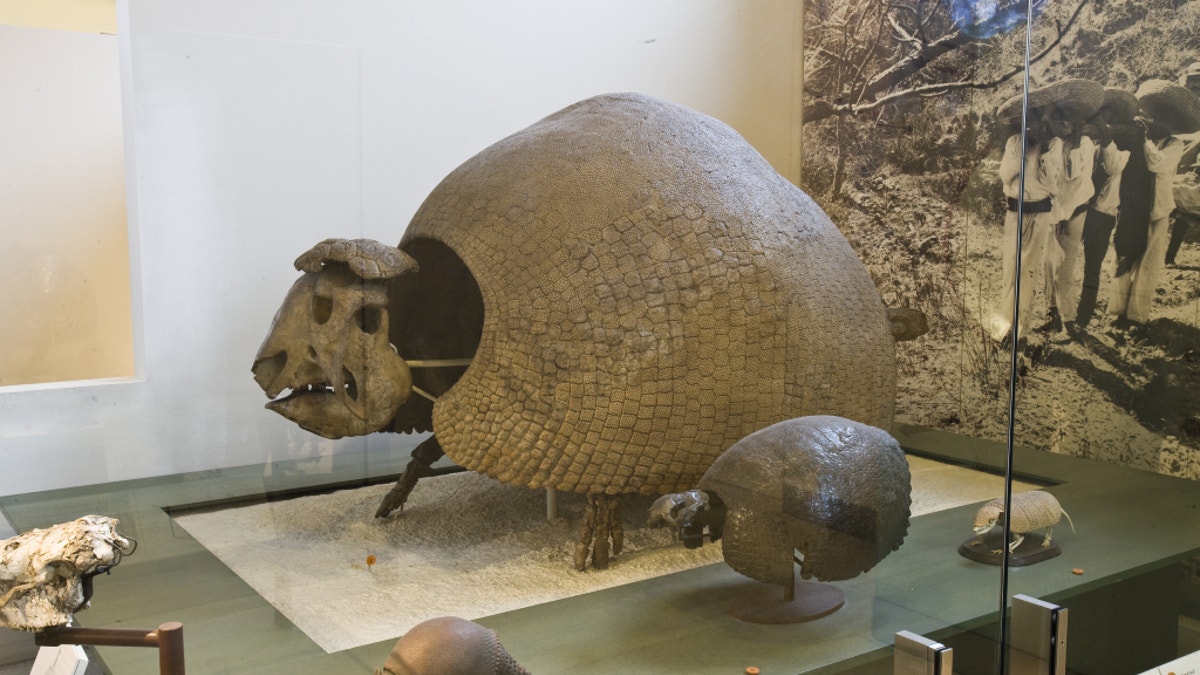
Two male glyptodonts (Doedicurus clavicaudatus) facing off: The massive, club-shaped tails were probably used more for intraspecific combat than defense against predators. (Peter Schouten)
With their bony exterior, armadillo’s have often been called living dinosaurs.
Now, a new study further confirms it by finding they are related the now extinct glyptodonts—huge, armored mammals that went extinct in the Americas at the end of the last ice age. The finding runs counter to the long held belief that the two groups must have separated early in their evolutionary history because they look so different.
In the study in the journal Current Biology, the researchers also found that the closest relatives of glyptodonts—some species of which may have weighed two tons or more—include not only the giant armadillo (Priodontes maximus), which can weigh up to 25 pounds, but also the four-ounce pink fairy armadillo, or pichiciego (Chlamyphorus truncatus).
Related: Fossil of massive crocodile found on edge of Sahara desert

The fossil of this glyptodont is on display in the Museum’s Hall of Primitive Mammals. (©American Museum of Natural History/D.Finnin)
“Contrary to what is generally assumed about the distinctiveness of glyptodonts, our analyses indicate that they originated only some 35 million years ago, well within the armadillo radiation,” Frédéric Delsuc, of the French National Center for Scientific Research at the University of Montpellier and of the study’s co-author’s, said in a statement. “Taxonomically, they should be regarded as no more than another subfamily of armadillos, which we can call Glyptodontinae.”
The remains of glyptodonts have been collected as far back as the early 19th century by the likes of Charles Darwin but few could figure out what kind of mammal they represented. It was eventually accepted that glyptodonts must be related in some way to armadillos, the only other New World mammals to develop a protective bony shell.
Delsuc and Hendrik Poinar of McMaster University confirmed the relationship with modern armadillos only after they started studying living xenarthrans, a group of placental mammals that includes anteaters and tree sloths as well as armadillos. But to ensure they covered everything, they wanted to include genomic evidence from extinct species using so-called “ancient” DNA techniques.
Related: Fossil of duck-billed dinosaur found along Alabama creek
They contacted Ross MacPhee, a curator in the American Museum of Natural History’s Department of Mammalogy who studies recent extinctions, for help in acquiring suitable material. With the assistance of South American colleagues at the Argentinian Museum of Natural Sciences in Buenos Aires and the Museum of La Plata, MacPhee presented them with a wide range of specimens. Only sample that worked - a carapace fragment of an undetermined species of Doedicurus, a gigantic glyptodont that lived until about 10,000 years ago.
The team successfully assembled the complete mitochondrial genome of Doedicurus and compared it to that of all modern xenarthrans.
“Ancient DNA has the potential to solve a number of evolutionary questions, but it is often extremely difficult to obtain endogenous DNA, that is, DNA actually belonging to the animal being sampled, rather than some contaminant,” Poinar said. “In this particular case, we used a technical trick that allowed us to selectively enrich our Doedicurus DNA extract so that we had enough endogenous genetic material to work with.”
Related: Pig-snouted turtle from dinosaur era discovered in Utah
Together, Delsuc and Poinar developed a set of computer-reconstructed ancestral sequences to design probes used for fishing Doedicurus mitochondrial fragments out of the complex ancient DNA extract in order to be able to reconstruct the complete mitogenome of this glyptodont.
The researchers found that instead of representing a very early, independent branch of armored xenarthrans, glyptodonts likely had a much later origin, from ancestors within lineages leading to the modern armadillo family Chlamyphoridae.
But there are still unresolved questions, including why supersized armadillos evolved in the first place? And why glyptodonts – which were a very successful group for most of their history – suddenly disappeared?
“Despite their ungainly appearance, different species of glyptodonts occupied habitats as distinct as open grassland and dense woodland, all the way from Patagonia to the southern parts of the continental United States,” MacPhee said. “Although their disappearance has been blamed on human depredation as well as climate change, some species persisted into the early part of the modern or Holocene epoch, long after the disappearance of mammoths and saber-toothed cats. Like the loss of giant ground sloths, mastodons, and dozens of other remarkable mammalian species, the precise cause of the New World megafaunal extinctions remains uncertain.”




















